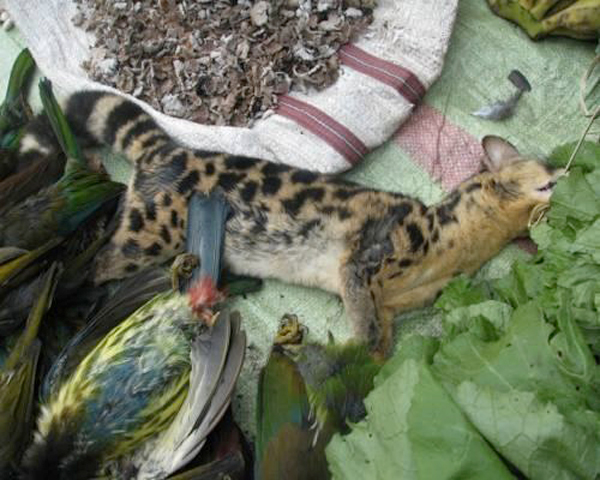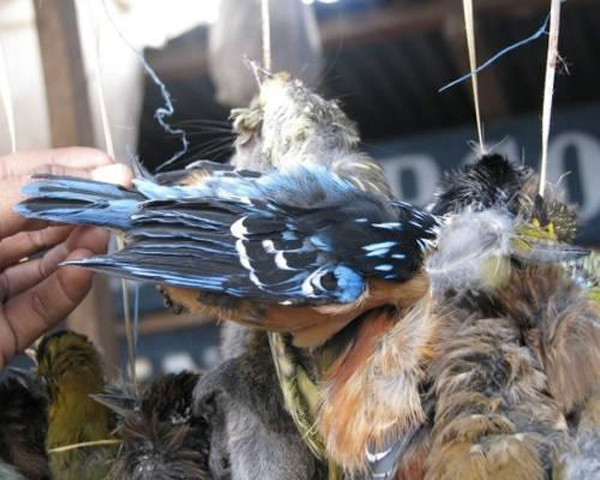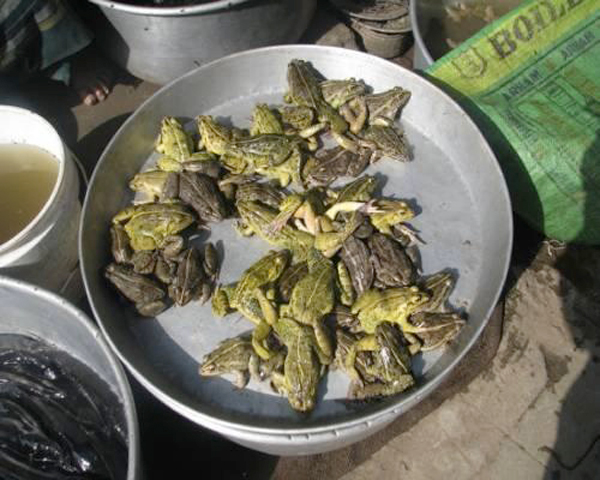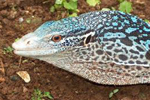A comprehensive survey of the wildlife sold in the markets of Tuensang has resulted in a stunning record of the wildlife trade in the state of Nagaland in northeast India, as reported in a new study published in mongabay.com’s open-access journal Tropical Conservation Science (TCS). Once a week, researchers with the Sálim Ali Centre for Ornithology and Natural History and the Near Chang Baptist group entered the Tuensang market and carried out intensive surveys and interviews of vendors selling wild birds or mammals. Researchers noted the species, price, and quantity of each animal then extrapolated their data to determine the implications for the conservation of the Nagaland wildlife, which, as apart of the Indo-Myanmar sub-region, is in one of the world’s 34 global biodiversity hotspots.
Eight different species of mammals, 35 species of birds, 2 species of amphibians and 2 species of mollusks were recorded after 52 surveys. The estimates suggest that a whopping total of 16,634 birds and mammals are sold each year in the Tuensang market alone. Out of that, 3,657 are mammals, and 13,067 are birds. The most common bird sold was the great barbet (Megalaima virens), which was recorded in the Tuensang market 264 times during the 52 surveys. The most common mammal was the Himalayan striped squirrel (Tamiops mcclellandii), which was recorded 159 times.

A spotted Linsang (Prionodon pardicolor) at a Tuensang market in eastern Nagaland. Photo by J.Paramanandham.
The study demonstrates the lack of enforcement and effect of local and national wildlife protection laws in Nagaland. The paper suggests that the lack of effectiveness is most likely due to strong native culture in Nagaland (only about 100 out of the 29,772 residents of Tuensang are non-natives), made up of some 225 native tribe. The researchers found that the animals in the markets were almost all hunted or collected by native tribes, such as the Chang, Yimchunger, Khiemungan, and Sangtam. India’s laws protect virtually all large wild animals from hunting, but these laws are often ignored in Nagaland because of cultural traditions of the tribesmen, who uses the animals for food, medicine, ritual purposes, or, a source of reliable income. Cultural taboos or preferences in the communities for specific species also dictated much of the market demand and pricing. For example, the common hoopoe (Upupa epops) is believed to cure asthma, and so is more expensive than other birds, and bought for often.
Adding to the problem is the fact that most of the habitats in Nagaland are locally owned. Ninety-three percent of the habitual land in Nagaland is owned and managed by clans, villages, individuals, and district councils. The remaining 7% is government-owned and protected, but the rest of the land is primarily used for hunting or Swidden (slash-and-burn) agriculture.
Overall, the researchers advocate for increased monitoring of all Nagaland markets to find out more about the use of wildlife in the state. But the article cautions that the cultural and economic aspects of the issue need the involvement and support of the locals in Nagaland before any meaningful change can be made.

Red Muntjac (Muntiacus muntjak) at a Tuensang market in eastern Nagaland. Photo by Ramesh Kumar.

Beautiful Nuthatch (Sitta formosa) at a Tuensang market in eastern Nagaland. Photo by Ramesh Kumar.

Amphibians at a Tuensang market in eastern Nagaland. Photo by P. Thirumalainathan.
CITATION: Bhupathy, S., Ramesh Kumar, S., Thirumalainathan, P., Paramanandham, J. and Chang Lemba. 2013. Wildlife exploitation: a market survey in Nagaland, North-eastern India. Tropical Conservation Science Vol. 6(2):241-253. Available online: www.tropicalconservationscience.org
Related articles
Illegal wildlife trade flourishes in Sumatra

(06/10/2013) In a chilly rain on Sunday, in a town just a few kilometers beyond the edge of a protected Sumatran rainforest, a young orangutan sat perched on a piece of plywood and grabbed the metal wires of his tiny cage.
He has sat in that cage for six months and, like dozens of other species on display in this ‘zoo’ in the town of Kadang in Aceh, he has a price tag. This packed assembly is an acknowledged front for illegal trafficking in wildlife.
African militias trading elephant ivory for weapons

(06/05/2013) The Lord’s Resistance Army (LRA) is using lucrative elephant poaching for ivory to fund its activities, according to a report published on Tuesday. Eyewitness accounts from park rangers, Lord’s Resistance Army (LRA) escapees and recent senior defectors report that the fugitive warlord Joseph Kony, who is wanted by the international criminal court for war crimes and crimes against humanity, ordered African forest elephants to be killed in Garamba national park in the Democratic Republic of Congo (DRC) and the tusks sent to him.
Loris champion: conserving the world’s most surprising primate family

(06/04/2013) Before Anna Nekaris began championing the cause of the world’s lorises, little was known about this cryptic family of large-eyed, nocturnal, insect-eating, venomous primates. Nekaris, with Oxford Brookes University and founder of the Little Fireface project, has been instrumental in documenting rarely-seen loris behavior, establishing conservation programs, and identifying new species of these hugely-imperiled Asian primates.
Monitor lizards vanishing to international trade in pets and skins

(06/04/2013) The world’s monitor lizards remind us that the world was once ruled by reptiles: this genus (Varanus) includes the world’s biggest lizards, such as the stunning Komodo dragon and many other island kings. A large number beautifully-colored and patterned, these lizards are known for their intelligence and their apex role in many island food chains. However, a new study finds that the world’s monitors, especially those in Southeast Asia, are vanishing due to the international pet trade and for their skins, which are turned into handbags and straps for watches. Meanwhile the rapid destruction of their rainforest homes is exacerbating the situation.
Manta ray tourism worth 28 times more than killing them for Traditional Chinese Medicine
(06/03/2013) A new study in the open access journal PLoS ONE estimates that manta rays are worth $140 million a year in tourism across 23 countries, significantly outweighing the worth of manta ray gill plates, which have become the newest craze in Traditional Chinese Medicine.
Kenya getting tough on poachers, set to increase fines and jail time
(05/29/2013) The Kenyan parliament has approved emergency measures to tackle the on-going poaching crisis: last week Kenyan MPs approved legislation that should lead to higher penalties for paochers. The emergency measure passed just as Kenya Wildlife Service’s (KWS) is pursuing a gang of poachers that slaughtered four rhinos over the weekend. Both rhinos and elephants have suffered heavily as poaching has escalated in Kenya and beyond.
Rhinos moved from South Africa to Botswana for safekeeping
(05/23/2013) A private safari company has moved six white rhinos (Ceratotherium simum) from their home in South Africa to Botswana in a bid to save them from an out-of-control poaching crisis in their native land. Currently, around two rhinos are killed everyday in South Africa for their horns, which are then smuggled to East Asia.
Prince Charles: take the war to the poachers
(05/22/2013) Prince Charles has warned that criminal gangs are turning to animal poaching, an unprecedented slaughter of species that can only be stopped by waging war on the perpetrators, in the latest of a series of increasingly outspoken speeches about the environment. Addressing a conference of conservationists at St James’s Palace in London, the Prince of Wales announced a meeting of heads of state to take place this autumn in London under government auspices to combat what he described as an emerging, militarized crisis.
Five percent of ploughshare tortoise population perishes after botched smuggling attempt
(05/14/2013) In March, two people were caught attempting to smuggle 54 ploughshare tortoises (Astrochelys yniphora) into Thailand. Listed as Critically Endangered, the tortoises’ wild population is down to approximately 400-500 animals in its native Madagascar, meaning the smugglers were attempting to move over 10 percent of the total population. Now, the Scientific American blog Extinction Countdown reports that nearly half of the smuggled tortoises have died of unknown causes.
17 poachers allegedly enter elephant stronghold in Congo, conservationists fear massacre

(05/07/2013) Local researchers and wildlife guards say 17 armed elephant poachers have gained access to Dzanga Bai, a large waterhole and clearing where up to 200 forest elephants visit daily in the Central African Republic (CAR)’s Dzanga-Ndoki National Park. WWF, which works in the region but has recently evacuated due to rising violence, is calling on the CAR government to rapidly mobilize its military to stop another elephant bloodbath in central Africa. Elephants are being killed across their range for their ivory, which is mostly smuggled to East Asia.